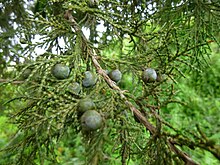East African juniper
| East African juniper | ||||||||||||
|---|---|---|---|---|---|---|---|---|---|---|---|---|

East African Juniper ( Juniperus procera ) in northern Tanzania |
||||||||||||
| Systematics | ||||||||||||
|
||||||||||||
| Scientific name | ||||||||||||
| Juniperus procera | ||||||||||||
| Maximum. ex Endl. |
The East African juniper ( Juniperus procera ) is a plant from the family of the cypress family (Cupressaceae). It is native to East Africa and the west of the Arabian Peninsula .
description
The East African juniper grows as an evergreen tree that can reach heights of growth of 30 to 40 meters and diameters of up to 1.5 meters at chest height . It is usually single-stemmed, but free-standing trees can also be multi-stemmed and usually branch just above the ground. The crown of young trees is pyramidal, becomes wider and more open with age, and takes on a dome-shaped, flattened or irregular shape. The long and thick branches of the first order descend from the trunk on older trees and ascend diagonally. Young trees have ascending branches which, however, become drooping with age. The initially smooth, purple-colored bark forms paper-like flakes after a short time. Old trees have a fibrous, pale brown or gray-brown bark with deep longitudinal cracks, which flake off in long and narrow strips. The branches, which are 0.6 to 1 millimeter thick and square in cross-section, emerge from the branches in a pinnate-shaped arrangement. They have an orange rind .
The light green leaves are alternate or arranged opposite to each other on the branches. Young leaves are needle-shaped with a length of 0.8 to 1 centimeter and a width of about 1 millimeter with a broad base and a pointed, piercing upper end. Older leaves are scale-like and with a length of 0.5 to 6 millimeters, obovate to triangular in shape. They overlap each other and have a smooth leaf edge, a flattened base and a free-standing tip. The scale sheets have two or more inconspicuous stomatal lines . Each leaf has a conspicuous, light green to yellowish green colored and linear-elliptical shaped gland .
The first green, later orange-brown male cones stand individually on the branches and are 3 to 5 millimeters long and 2 to 3 millimeters thick. They contain ten to twelve shield-shaped microsporophylls with serrated edges which carry two to three pollen sacs . The sessile or short-stalked female cones are spherical with a diameter of 3 to 7 millimeters. They are initially bluish-green in color and when ripe they change color to purple-black and have bluish frosting. They are soft and covered with wax. Each cone has four to six fully grown together seed scales and carries one to four seeds. The yellowish brown seeds are angular-egg-shaped with a length of 4 to 5 millimeters and a width of 3 to 3.5 millimeters.
Occurrence
The natural range of the East African juniper lies in the east of Africa and in the west of the Arabian Peninsula . In Africa, the distribution area extends from northeast Sudan in the north over the highlands of Abyssinia , Eritrea , Djibouti , Somalia , Kenya , Eastern Congo , Uganda , Tanzania , Malawi , Mozambique and Zambia to northeast Zimbabwe in the south. On the Arabian Peninsula, the species is found in the mountains of Saudi Arabia and Yemen , bordering the Red Sea .
The East African juniper thrives at altitudes of 1050 to 3600 meters. It occurs mainly in mountainous areas, but also in savannas . The annual rainfall is between 400 and more than 1300 mm, depending on the location. In Africa there is a dry season of around five months, while in the Arabian Peninsula most precipitation falls in the winter months. In the mountains, the East African juniper grows mainly in open hardwood forests , in which it has both pure and mixed stands with the slim Afro yellowwood ( Afrocarpus gracilior ), Cornus volkensii and Xymalos monospora as well as with various types of agauria , coral trees ( Erythrina ), Nuxia and Forms olive trees ( Olea ).
Hazard and protection
The East African juniper is classified as "not endangered" in the IUCN Red List . Forest felling and changes to the landscape, together with a low level of rejuvenation, are named as the main risk factors.
Systematics
It was first described as Juniperus procera in 1847 by Christian Ferdinand Friedrich Hochstetter in Synopsis Coniferarum , page 26. A synonym for Juniperus procera Hochst. ex Endl. is Sabina procera (Hochst. ex Endl.) Antoine .
use
The wood of the East African juniper is used as construction wood and fuel and essential oils (Kenya, Ostarika cedar oil ) can be obtained from its plant parts . It is also used as an ornamental wood . The wood is also offered under the name "Kenya cedar".
swell
- Christopher J. Earle: Juniperus procera. In: The Gymnosperm Database. www.conifers.org, November 23, 2012, accessed December 8, 2012 .
Individual evidence
- ↑ a b c d e Christopher J. Earle: Juniperus procera. In: The Gymnosperm Database. www.conifers.org, November 23, 2012, accessed December 8, 2012 .
- ↑ a b Juniperus procera. In: Germplasm Resources Information Network. www.ars-grin.gov, accessed December 8, 2012 (English).
- ↑ a b Juniperus procera in the IUCN Red List of Threatened Species 2014.3. Posted by: Farjon, A., 2011. Retrieved December 12, 2015.
- ↑ Juniperus procera at Tropicos.org. Missouri Botanical Garden, St. Louis, accessed December 8, 2012.
- ↑ Steffen Arctander (Ed.): Perfume and Flavor Materials of Natural Origin. Denmark 1960, pp. 140 f, online at babel.hathitrust.org, accessed on November 16, 2017.
